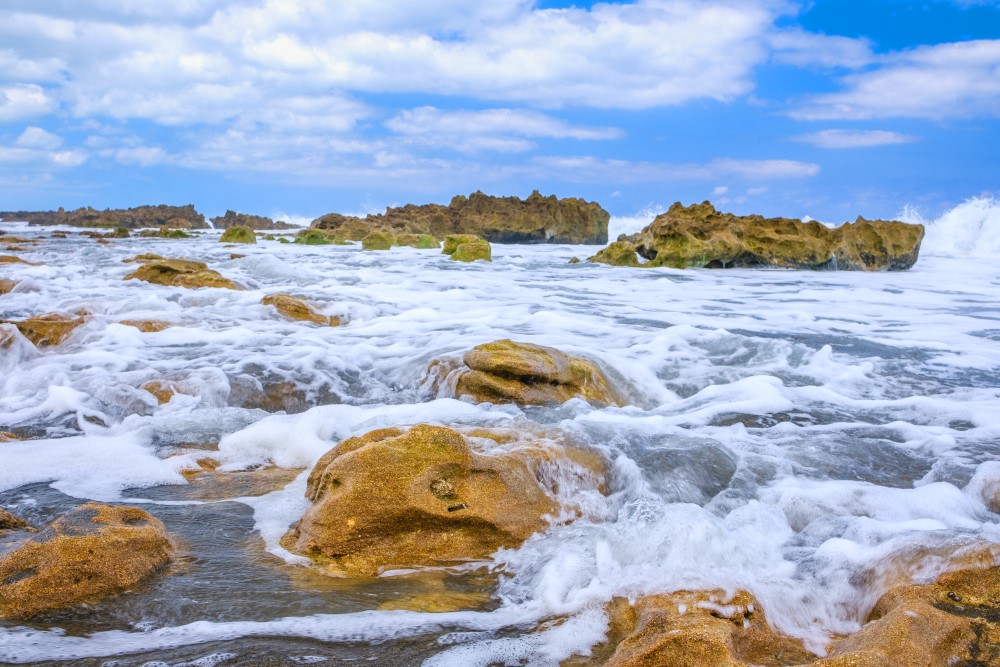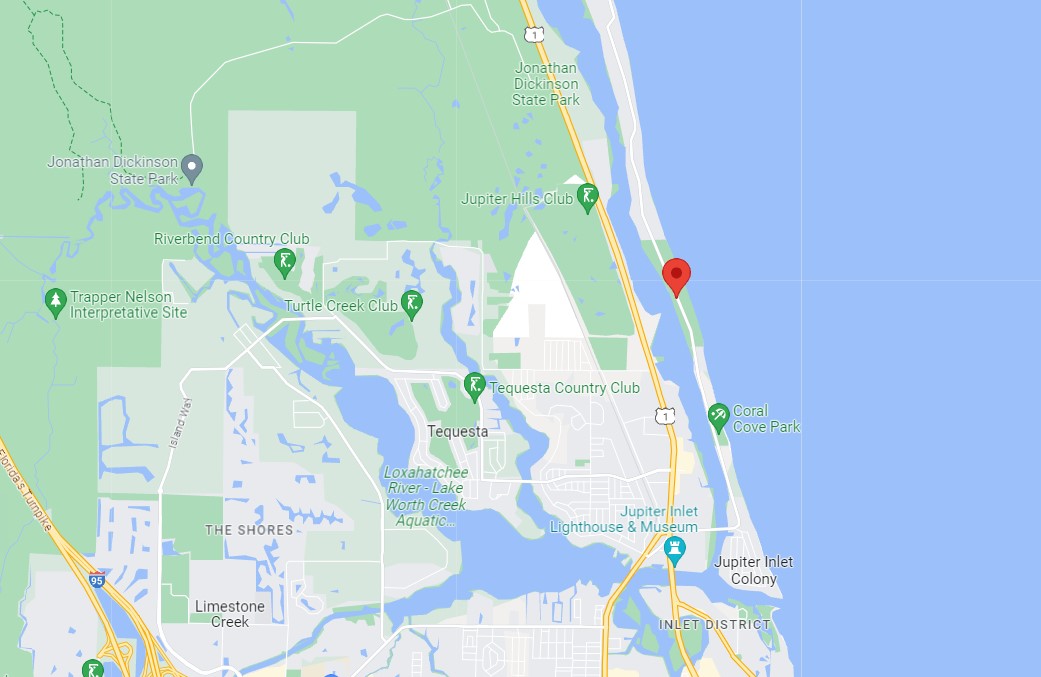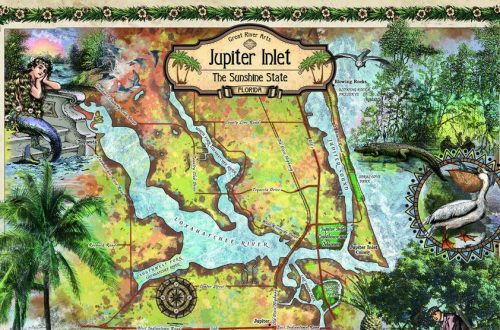Blowing Rocks Preserve
Tucked away on Jupiter Island, Florida, Blowing Rocks Preserve is an ecological and geological treasure waiting to be discovered. This 73-acre barrier island sanctuary, managed by The Nature Conservancy, provides a stunning display of coastal beauty and a unique natural phenomenon. Visitors can explore diverse ecosystems, marvel at breathtaking rock formations, and witness the extraordinary ‘blowing rocks’ for which the preserve is named. In this article, we will delve into the wonders of Blowing Rocks Preserve and offer insights on how to make the most of your visit to this hidden gem.
The Geological Wonder: Anastasia Limestone
The heart of Blowing Rocks Preserve lies in its most distinctive feature: the Anastasia Limestone outcroppings. These ancient rocks, formed over 125,000 years ago during the Pleistocene Epoch, stretch along the shoreline and create a dramatic backdrop for the churning Atlantic Ocean. The Anastasia Limestone is a sedimentary rock primarily composed of coquina shells, which lend the formations a unique, fossilized appearance.
The Blowing Rocks Phenomenon
The preserve’s namesake comes from the awe-inspiring spectacle that occurs when waves crash against the jagged limestone formations. As water is forced through the crevices and holes in the rock, it creates impressive plumes of seawater that can reach heights of up to 50 feet. The best time to witness this natural display is during high tide or periods of rough seas, particularly during winter months when the ocean is more turbulent.
Diverse Ecosystems and Wildlife
Blowing Rocks Preserve is home to several distinct ecosystems, including coastal strand, maritime hammock, and mangrove wetlands. These habitats support a wide array of wildlife, such as sea turtles, gopher tortoises, and ospreys. In addition to being an important nesting site for endangered sea turtles, the preserve offers a sanctuary for migratory birds and various plant species, some of which are native to the area.
Activities and Amenities
Visitors to Blowing Rocks Preserve can engage in a variety of recreational activities, such as hiking, birdwatching, and photography. The well-maintained trails offer an opportunity to explore the diverse habitats and admire the stunning landscape. The beach is also a popular spot for beachcombing and swimming, but be mindful of the sharp limestone formations.
The Hawley Education Center, located within the preserve, provides an informative introduction to the area’s ecology and history. Here, visitors can learn about the region’s plant and animal life, the importance of barrier islands, and the ongoing conservation efforts by The Nature Conservancy. Restrooms and picnic facilities are also available on-site.

Tips for Visiting
- Plan your visit around high tide: To witness the ‘blowing rocks’ at their most spectacular, check the tide charts and plan your trip accordingly.
- Wear appropriate footwear: The rocky shoreline can be slippery and sharp, so it’s best to wear sturdy shoes that protect your feet.
- Respect the environment: Admire wildlife from a distance, and do not disturb nesting sea turtles or migratory birds. Follow the preserve’s guidelines and refrain from littering or damaging vegetation.
- Apply sun protection: Florida’s sun can be intense, so make sure to wear sunscreen, sunglasses, and a hat during your visit.
Blowing Rocks Preserve offers a unique experience for nature lovers, geology enthusiasts, and anyone seeking a tranquil escape from the bustling world. The beautiful landscapes, fascinating geological formations, and diverse ecosystems make it a must-visit destination on Florida’s Atlantic coast. By exploring this hidden gem, you can not only appreciate the natural beauty but also contribute to the ongoing efforts to protect and preserve these precious environments
The Nature Conservancy
Open seven days a week from 9:00 a.m. to 4:30 p.m.
The preserve is closed on Easter Sunday, Thanksgiving Day, Christmas Eve, Christmas Day and New Year’s Day.
HIGHLIGHTS
Enjoy swimming and snorkeling from the protected beach. Observe rare birds, plants and animals on three hiking trails.
SIZE
73 acres
Directions
Directions
Directions from I-95 (from the north):
From southbound I-95, take exit 96, County Hwy-708 toward Hobe Sound.
Keep left on the ramp toward Hobe Sound.
Turn left onto SE Bridge Rd/County Hwy-708.
Turn right onto S Beach Rd/ County Hwy-707.
BRP main parking lot will be on your right with extra parking to the left.
Directions from I-95 (from the south):
From northbound I-95, take Exit 79A onto SR-786 East, PGA Blvd.
Keep right to turn on Lake Victoria Gardens Ave.
Turn right onto Highway A1A Alt.
Continue straight onto Beach Rd.
Take a slight right turn then stay straight.
On your left is the BRP main parking lot with extra parking to the right.
Directions from Florida’s Turnpike (from the north):
Note: This route requires tolls.
From Florida’s Turnpike southbound, take the exit 116 Fl-706 toward Jupiter.
Turn left onto W Indiantown Rd/Fl-706.
Turn left onto Old Dixie Highway/FL-A1A Alt.
Continue on FL 811/FL-A1A Alt. This will become Beach Rd/County Hwy-707.
BRP main parking lot will be on your left with extra parking to the right.
Directions from Florida’s Turnpike (from the south):
Note: This route requires tolls.
From Florida’s Turnpike northbound, take Exit 109, FL-786/PGA Blvd.
Keep right at the fork in the ramp. Next, take a left at the fork in the ramp.
Turn left onto PGA Blvd/FL-786.
Take a left onto Central Blvd.
Turn right on Hood Rd.
Take a left onto Highway A1A Alt/Fl-A1A Alt.
Continue straight on FL-811/FL-A1A Alt. This will become Beach Rd/County Hwy-707.
BRP main parking lot will be on your left with extra parking to the right.





